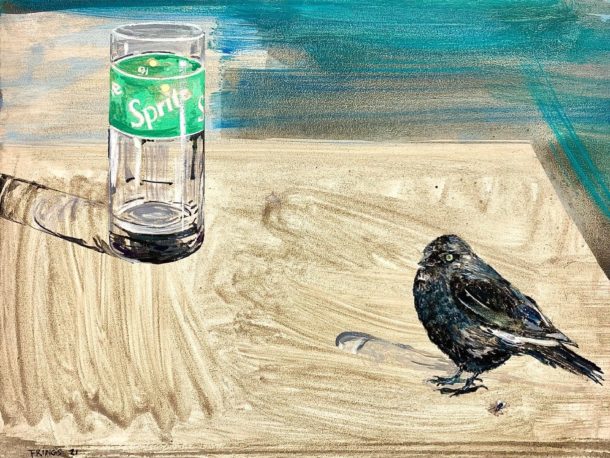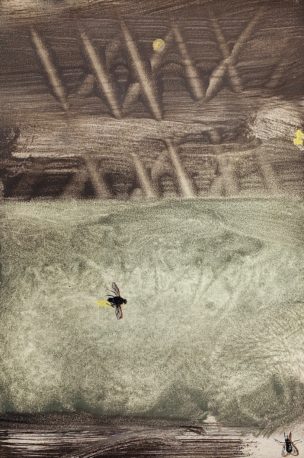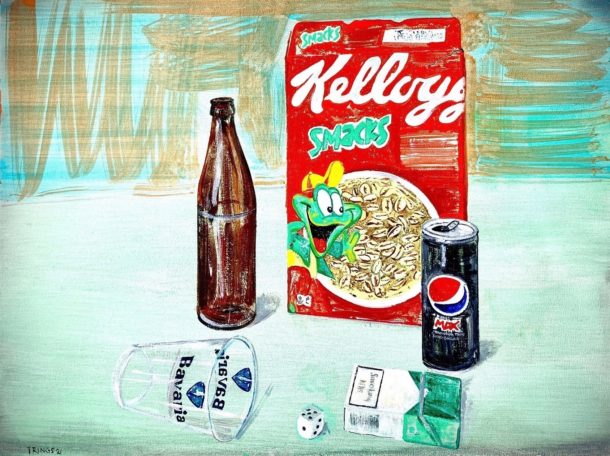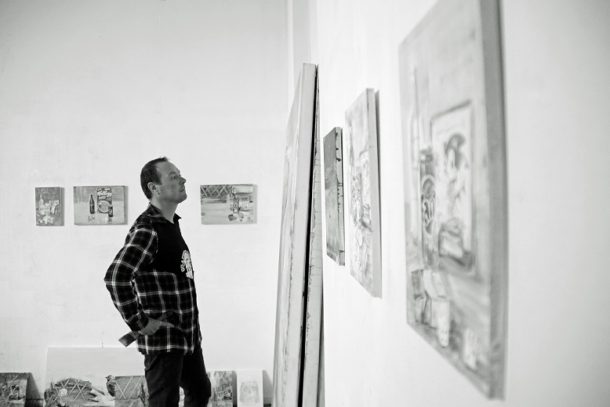World Fine Art Professionals and their Key-Pieces, 335 - Bert Frings Revisited
World Fine Art Professionals and their Key-Pieces, 335 – Bert Frings Revisited
In 2015 I visited the studio of Bert Frings in the Ruilstraat in Rotterdam. Six years later I visit him again as a result of the new work he made during the corona period.
Immediately behind the door he put an extra floor. For the storage of paintings. Bert Frings: ‘The corona time was a special time. How long would it take? How contagious was it? It was an uncertain time. But also a good reason to clear your head.’
Smaller and different
When the lockdown due to corona started in March 2020, he initially went to his studio less. He stayed at home to work at the kitchen table. And he looked at things around him, at home but also at what he found on the street.
“What did I see? Chip forks, cigarette butts, cans and bottles, Fanta, Red Bull. All kinds of things people throw on the street.” Bert started working smaller and differently. He started making drawings on paper, which he later turned into paintings. No longer on linen, but on panel. And no longer with acrylic paint, but with egg tempera that he partly made himself.
Egg tempera
He shows a pencil drawing of a bottle and a small panel of a bottle in blue. Bert: “In the beginning it was a complete Reset, which made me think ‘What do I find important’, ‘what really matters humanly?’ I wanted to dig into this and focus on the still life.”
The egg tempera have a different effect. “It’s velvety. There’s more happening. Acrylic has a plastic appearance. You can also correct with tempera. It is also much better in terms of footprint.”
Egg tempera fits better with the small-sized panels, he notes. “I started with watercolor, but quickly became very skilled with tempera. I have now included the stickers, for example from Pepsi, which previously seemed to be stuck on some works, they have dissolved as an object in the work, as it were.”
FANTA
The new works hang side by side on the wall. We walk to a work with, among other things, a bottle of Fanta. Bert has a nice story about it. Fanta appears to have originated in the Second World War in Germany. Coca-Cola Germany could no longer get the right ingredients and therefore started making a replacement soft drink according to its own recipe. When they had trouble finding a name for the recipe, one employee said to another, “Dude, use your FANTAsie” And so the name FANTA was born. After the war, the Fanta brand name and recipe were transferred to Coca Cola’s headquarters.
Finiteness
One of the still life painters of the Golden Age was Pieter Claesz. He painted all kinds of things that referred to the fragility and finiteness of life, vanitas paintings. They return in the new works of Bert Frings. “He showed nuts with and without shells, lemon peels, glasses, whether or not knocked over, bubbles, skulls.” Elements of it return in Frings works, but from the 21st century. Like, for example, a soda drink refers to air bubbles.
Jackdaw
I see a game cartridge from Jurassic Park, a bag of chips from Bram Ladage, a coin and a bird, a jackdaw. “This jackdaw was not completely healthy, it was a leucistic jackdaw, it had a number of white feathers and was therefore easy to recognize. I occasionally gave him something to eat in the garden, so a bond was formed. I also saw him outside the garden. We recognized each other. We even gave him a name. Later he flew less and less. At Christmas he was suddenly gone, probably dead. Jackdaws are special birds: always together, they even share food. There is a huge development in the way we treat animals. Certainly in art you see more and more that animals are also individuals. Instead of symbolizing people or human qualities.”
Ambrosius Bosschaert the Younger
For the bird he was inspired by the work of Ambrosius Bosschaert the Younger. “He is the son of Abrosius Bosschaert the Elder, who is better known, his work hangs in the Mauritshuis, for example. A work by his son can be seen at Fondation Custodia in Paris – a dead frog with flies.”
And indeed, I also see dead flies here and there in the work of Bert Frings. “The young Bosschaert went further and further. The frog’s body shines because of the copper that served as the base for the oil paint. It’s all about transience. And what is very special, it is timeless.”
Masaccio, Van der Weyden, Engebrechtsz.
Another work that inspired him was Masaccio’s famous Holy Trinity, which has a skeleton on a tomb painted with the text: I was what thou art and thou shalt be what I am. “Masaccio is a nickname given to him by Vasari and refers to his personal hygiene which he neglected. He didn’t have time for that, he had to paint.”
“Rogier van der Weyden painted a diptych a skull and a grave cross. They were the first still lifes. They were called ‘skulls’. These images of skulls were of great influence on the development of the vanitas still life.”
Another favorite work by Bert Frings hangs in the Lakenhal in Leiden. It is by Cornelis Engebrechtsz, a triptych. “In the lower part, a tree grows from the corpse of Adam, from which, according to legend, the wood of the cross was made. He has painted a crucifixion of Christ with the skull of Adam at the bottom of the cross. One of the traditions of the vanitas still life is the skull.”
The term still life
The term still life is special, says Bert. Bernlef wrote a poem about it, commenting it as follows:
“Still life
What a wonderful word: a life that is still, but still: alive (compare the French ‘nature mort’, which completely misses the point – as if it were about a kind of ‘death’. On the contrary. Moving between death and life, in a no man’s land.
The second meaning of the word is related to the first. You have to live extremely still to be able to make a still life.”
Michael Jackson
On a painting we see Pepsi, a dead fly and on the back of the painting the letters ‘BAD’. “That refers to Michael Jackson. He had everything but ended up with nothing. The beginning of his end was when he worked on a Pepsi commercial. His hair caught fire. He started taking care of his skin and from then on it all went downhill.”
Later in the year there will be an exhibition of this new series of works by Bert Frings at Walgenbach Art & Books.
Images
1) Bert Frings, Mickel III, 2021, tempera on panel, 30 x 40 cm, 2) Bert Frings, As I Am You Will Be, 2020, tempera on panel, 30 x 20 cm, 3) Bert Frings, Still Life With Frog, 2021, tempera on panel, 30 x 40 cm, 4) studio photo Bert Frings by Linda Cook
https://www.instagram.com/stilllifewithfrogandflies/
https://www.instagram.com/bertfrings2017/
http://www.bertfrings.com/
https://ifthenisnow.eu/nl/verhalen/bert-frings-revisited
Disclaimer: The views, opinions and positions expressed within this guest article are those of the author Walter van Teeffelen alone and do not represent those of the Marbella Marbella website. The accuracy, completeness and validity of any statements made within this article are not guaranteed. We accept no liability for any errors, omissions or representations. The copyright of this content belongs to Walter van Teeffelen and any liability with regards to infringement of intellectual property rights remains with the author.



















The opinions expressed by individual commentators and contributors do not necessarily constitute this website's position on the particular topic.